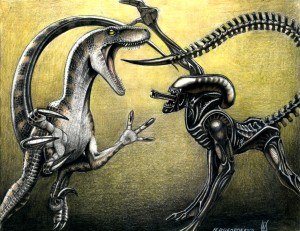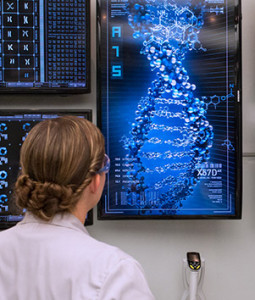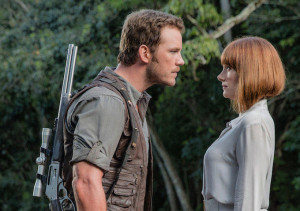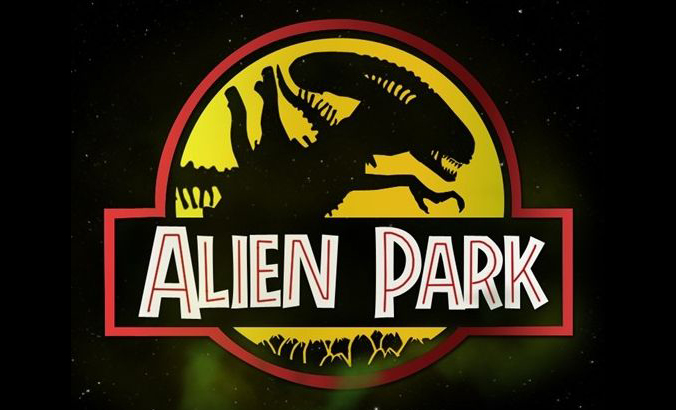The ALIEN & JURASSIC Quadrilogy Parallels
With the fourth instalment to the Jurassic Park film franchise now in cinemas, I have been musing about its parallels to another great series – The Alien Quadrilogy. Now, as you start thinking about parallels between any two things, you will often see connections that don’t actually exist. I heartily guarantee that that is what I have done here. But hey, if you like movies like I do, and you don’t mind having fun comparing two awesome film series, then read on! (Also, it is worth noting that I may be discussing some key plot points or themes from all of the movies, so **MULTIPLE SPOILER ALERTS**)
THE “MONSTERS”
 The first, and simplest parallel is that they are both sort-of “monster” movies, and the beasts in each series are called that as well. In Aliens, the young girl named Newt says: “My mommy always said there were no monsters – no real ones – but there are.”, and in Jurassic Park, the young girl named Lex says: “Don’t let the monsters come over here.” The movies follow a lot of the standard monster movie plotlines, with scary things lurking behind every corner and people in peril trying to fight or flee from strange and deadly creatures. In both series, the threatening monsters are lizard-like, generally standing on two legs, with a long tail and a mouthful of sharp teeth. In a real stretch, trying to parallel these two monsters, I even recall that in Alien 3 one of the characters, Golic, calls the alien a “dragon” and there is a theory that dragons became part of our mythologies across the world in various cultures due to ancient interactions between humans and dinosaurs.
The first, and simplest parallel is that they are both sort-of “monster” movies, and the beasts in each series are called that as well. In Aliens, the young girl named Newt says: “My mommy always said there were no monsters – no real ones – but there are.”, and in Jurassic Park, the young girl named Lex says: “Don’t let the monsters come over here.” The movies follow a lot of the standard monster movie plotlines, with scary things lurking behind every corner and people in peril trying to fight or flee from strange and deadly creatures. In both series, the threatening monsters are lizard-like, generally standing on two legs, with a long tail and a mouthful of sharp teeth. In a real stretch, trying to parallel these two monsters, I even recall that in Alien 3 one of the characters, Golic, calls the alien a “dragon” and there is a theory that dragons became part of our mythologies across the world in various cultures due to ancient interactions between humans and dinosaurs.
Having said that, the reason why I say they are “sort of” monster movies, is because in both series the young girls are actually wrong to call them by that name. As Dr Grant says in Jurassic Park, “They’re not monsters, Lex. They’re just animals.” In neither series are the creatures portrayed as mythical or magical. They are simply a different species (however physically superior) to humans – one being an alien and the other being a dinosaur. In regard to storytelling, this adds to the drama in a way that wouldn’t be as effective if they were actually “monsters”. You can imagine them being real and you can put yourself in the shoes of the humans. Fortunately though, because both aliens and dinosaurs are not part of our present lives on earth, their separation from our experience makes them more fantastical and open to more interpretation. This of course makes for great cinema, as both aliens and dinosaurs can be grounded in reality and fantasy at the same time.
THE THEMES
Man vs Nature
There are many common themes scattered throughout the Aliens and Jurassic quadrilogies. There is the whole “man vs nature” battle, exploring the folly of human beings to think they can control a powerful natural force, as represented by the aliens/dinosaurs. For the Jurassic series, this is the #1 main theme in Jurassic Park as Dr Ellie Sattler says, “The question is, how can you know anything about an extinct ecosystem? And therefore, how could you ever assume that you can control it?” It is also a small theme in The Lost World, where the character Sarah Harding thinks she can only “observe and document, not interact.” and Ian Malcolm points out that that is “a scientific impossibility. Heisenberg Uncertainty Principle. What you study, you change.” It’s not so much of a theme in Jurassic Park 3 (the weakest of the quadrilogy) but it definitely comes back as a big theme in Jurassic World, where there are characters trying to train dinosaurs, contain dinosaurs, genetically modify dinosaurs and use them for a variety of evil purposes. In the Aliens series, this theme is strongest in the second instalment, Aliens, with the arrogance of the marines thinking it will be easy to kill the aliens, but like the Jurassic series it definitely comes back in the fourth film, Alien: Resurrection, where there are characters trying to train aliens, contain aliens, genetically modify aliens and use them for a variety of evil purposes.
Genetics
Touching on “genetic modification”, I would actually say is its own theme worth discussing as it plays into both series in important ways. In the Aliens series, the alien takes on the genetic characteristics of the species that it bursts out of. This is not pointed out in the first two movies (though it is consistent with their humanoid arms and legs), but it is demonstrated in Alien 3 where the alien bursts out of a dog (or a bull in the far superior director’s cut version) and consequently runs around on all fours. This genetic modification means that the alien can improve upon and have an advantage over the species in its vicinity (if a ridiculously fast life cycle and acid for blood wasn’t enough). In the Jurassic series, the dinosaurs only exist because they have been genetically combined with the DNA of frogs. This genetic modification meant that the dinosaurs could spontaneously change gender to get past the “all dinosaurs are girls” limitation and ensuring their advantage over the humans. In both cases “life will find a way” for humans to be on the menu.
 As well as this, the writers of both series apparently run out of good ideas and in the fourth film of both series, the arrogant humans begin making genetically modified hybrid creatures. In Alien: Resurrection, Ripley (or the clone of Ripley) is a genetic hybrid of human and alien and there is also a big bad alien that is a genetic hybrid of human and alien as well. In Jurassic World, the big bad Indominus Rex is a genetic hybrid of T-Rex, Velociraptor, Carnotaurus, Giganotosaurus, Majungasaurus, Rugops, Cuttlefish and tree frog. And why did the scientists in both series use genetic modification in their respective fourth film? So they could turn their monster into a weapon to be used by the military. Yikes! If that’s not a parallel, I don’t know what is! Personally, I think both series were just trying to “increase the wow factor” and by the fourth movie in the franchise, they didn’t leave themselves many places to go other than creating weaponised hybrid monsters. It may have nicely fit in the overarching “men vs nature” theme, but as I’d have to agree with Chris Pratt’s character, Owen Grady when he says, “Probably not a good idea.”
As well as this, the writers of both series apparently run out of good ideas and in the fourth film of both series, the arrogant humans begin making genetically modified hybrid creatures. In Alien: Resurrection, Ripley (or the clone of Ripley) is a genetic hybrid of human and alien and there is also a big bad alien that is a genetic hybrid of human and alien as well. In Jurassic World, the big bad Indominus Rex is a genetic hybrid of T-Rex, Velociraptor, Carnotaurus, Giganotosaurus, Majungasaurus, Rugops, Cuttlefish and tree frog. And why did the scientists in both series use genetic modification in their respective fourth film? So they could turn their monster into a weapon to be used by the military. Yikes! If that’s not a parallel, I don’t know what is! Personally, I think both series were just trying to “increase the wow factor” and by the fourth movie in the franchise, they didn’t leave themselves many places to go other than creating weaponised hybrid monsters. It may have nicely fit in the overarching “men vs nature” theme, but as I’d have to agree with Chris Pratt’s character, Owen Grady when he says, “Probably not a good idea.”
Corporations
A big theme in both quadrilogies is the Corporate Machine. In the Aliens series, the corporation is Weyland industries – a company that travels to distant worlds and turns them into financially viable habitats. In the Jurassic series, the corporation is InGen – a company that travels to distant islands and turns them into financially viable theme parks. Both companies are greedy, idealistic, deceptive and interested primarily in how they might use the creature, rather than protect the people it might kill. In the first movies of both series, there is no one person who represents the coldness of the company – In Alien there is the robot, Ash (who is cold but not really human) and in Jurassic Park there is Dr John Hammond (who is human but not really cold). In the second movie of both franchise they really bring in perfectly slimy, corporate villain in the character Carter Burke (Aliens) and the character Peter Ludlow (The Lost World). Both of these villains are not personally violent or aggressive. They simply represent the interests of the corporation and in the second movie of both series, they share the storyline of being willing to put people in harms way in order to try to capture the creature and bring it back to the general population.
Women
Another theme in both quadrilogies is women and motherhood. This wasn’t going to be the way for Alien, as the iconic lead female character of Ellen Ripley was originally a man named Martin Roby in the first draft of the script, but the producer decided to change it to a woman, casting the then-unknown actress Sigorney Weaver in the role, and the rest is history.  Aliens, the second in the series, saw the return of Ripley as the kick-ass female heroine, but they added a new element, the little girl, Newt. The maternal themes are very strong as Ripley does everything to protect and rescue Newt from the other motherly figure in the film – the Queen Alien. The final battle involving Ripley, the Queen and Newt is fantastic and a great scene of feminine strength, containing the most awesome line of the entire quadrilogy… “Get away from her you BITCH!”. This motherhood theme is even more emphasised in the director’s cut of Aliens, where we have a scene that was cut from the theatrical release. In it, we find out that Ripley had a daughter back on earth, but sadly, as Ripley was in hypersleep for 57 years (between the first and second film), her daughter had died at the age of 66, only 2 years before Ripley was woken up. This grief of the lost of her child, was clearly supposed to be part of the maternal driving force behind her desire to look after Newt at all costs.
In the next two Alien films the motherhood theme continues with Ripley being impregnated with a Queen alien in Alien 3, which she discovered while getting an ultrasound (evoking a very maternal scene) and even when the alien bursts out of her in the final scene she holds it to her breast lovingly. In the fourth film, Alien: Resurrection the final scene shows the hybrid alien rejecting its real Alien mother and turning to Ripley believing she is actually her mother.
In the Jurassic quadrilogy, womanhood and maternal themes are also present. In almost all four films there are strong female characters: In Jurassic Park, there’s the strong, intelligent paleobotanist, Ellie Satler who doesn’t mind digging her hands into a giant pile of dino poop, and has the funny line, “Dinosaurs eat man. Woman inherits the earth.” Alongside her, there’s also the young, sassy character of Lex, who is a computer hacker and ends up saving the day by getting the security system back on line. In The Lost World, we have Dr Sarah Harding, a rouge behavioural paleontologist who doesn’t worry about being around dinosaurs because, as she says, “I’ve worked around predators since I was 20 years old – Lions, jackals, hyenas.” There is also the annoying 12 year old character, Kelly Curtis, whose gymnastics scene is regarded as one of the most ridiculous in the entire quadrilogy, but she is also noted by fans as being the only person in the entire series who successfully kills a velociraptor, so she’s not at all a damsel in distress – just a terrible actor.
The Lost World, also has the theme of parenthood amongst the dinosaurs at its core. Dr Sarah Harding says that the reason why she is on the island is because she is “trying to change 100 years of entrenched dogma. Dinosaurs were characterised very early on as vicious lizards. There’s a great deal of resistance to the idea of them as nurturing parents. Robert Burke said that the T.rex was a rogue, who would abandon its young at the earliest opportunity… I can prove otherwise.” And the conclusion of the movie is that she does prove otherwise as shown by the very final scene of T-Rex couple caring for their young, along with other dinosaurs doing the same.
In Jurassic Park 3 & Jurassic World (the two Speilberg didn’t direct), the themes of motherhood are present, but sadly they drop the ball in terms of strong female characters. In fact, recently there  has been much discussion about Jurassic World’s character, Claire Dearing, and whether her character is in fact, a sexist caricature. After seeing one scene with her in it, Joss Whedon (writer/director of Marvel’s Avengers) tweeted that he was “wishing this clip wasn’t ’70s-era sexist. She’s a stiff, he’s a life-force – really? Still?” In Jurassic World, Claire is a hard working single woman who manages an enormous theme park, but instead of being portrayed as intelligent, strong and resourceful, they made her emotionally stagnate, incompetent, ignorant and generally a bad person for being too busy to look after her nephews. In a conversation with her sister over the phone she pines for the sad reality that she thinks she’ll never have children, and he sister quickly encourages her, “Don’t talk like that. It’ll happen for you. One day.” and a little later her sister begins crying and tells Claire that she’d understand if she were a mother. I’m not saying that the desire to be a mother isn’t a worthwhile theme. It just wasn’t done with any sophistication or with respect to single working women. If this weren’t enough, the velociraptors, which were untameable female killing machines in the first film, are in Jurassic World, able to be trained by Owen Grady because he is the “alpha” and in the end, Claire seems to get her wish of being a mum when Owen tames her as well, grabbing and kissing her in that painfully old fashioned mucho man way. The one glimmer of hope was when the comic relief character, Lowery Cruthers, swoops in to give his female coworker a similar kiss and she stops him and explains that she has a boyfriend. It was probably the funniest moment of the film and for me, it redeemed a little bit of the 2-dimensional gender stereotyping.
has been much discussion about Jurassic World’s character, Claire Dearing, and whether her character is in fact, a sexist caricature. After seeing one scene with her in it, Joss Whedon (writer/director of Marvel’s Avengers) tweeted that he was “wishing this clip wasn’t ’70s-era sexist. She’s a stiff, he’s a life-force – really? Still?” In Jurassic World, Claire is a hard working single woman who manages an enormous theme park, but instead of being portrayed as intelligent, strong and resourceful, they made her emotionally stagnate, incompetent, ignorant and generally a bad person for being too busy to look after her nephews. In a conversation with her sister over the phone she pines for the sad reality that she thinks she’ll never have children, and he sister quickly encourages her, “Don’t talk like that. It’ll happen for you. One day.” and a little later her sister begins crying and tells Claire that she’d understand if she were a mother. I’m not saying that the desire to be a mother isn’t a worthwhile theme. It just wasn’t done with any sophistication or with respect to single working women. If this weren’t enough, the velociraptors, which were untameable female killing machines in the first film, are in Jurassic World, able to be trained by Owen Grady because he is the “alpha” and in the end, Claire seems to get her wish of being a mum when Owen tames her as well, grabbing and kissing her in that painfully old fashioned mucho man way. The one glimmer of hope was when the comic relief character, Lowery Cruthers, swoops in to give his female coworker a similar kiss and she stops him and explains that she has a boyfriend. It was probably the funniest moment of the film and for me, it redeemed a little bit of the 2-dimensional gender stereotyping.
THE QUADRILOGY
Now you may think I’ve just been cherry-picking themes that match and ignoring the themes that are different between the two series… and you’d be absolutely right. There’s heaps of things I’ve ignored because they don’t line up. I make no claim that these films were deliberately trying to copy each other. I’ve just been noticing some things that do seem to match. I’ll finish this post with a summary of each film, side by side, so you can see the parallels that I have been noticing.
Film 1/4: “Alien” & “Jurassic Park”
A small group is requested to travel to a distant, isolated place where they discover an amazing species they never believed could exist. This lizard-like creature then begins killing everyone and they spend the rest of the movie hunting, running away, hiding and trying to escape to safety. This movie is the first of the series and it is a simple, classic and brilliantly directed movie. It is regarded by the fans as the best one of the quadrilogy.
Film 2/4: “Aliens” & “The Lost World”
One character from the first film is vowing never to return to the place where the lizard-like creatures were, but after they are told that other people have already gone there and they have lost contact with them, they are convinced to go there to try to rescue them. As a sequel, this film tries to be bigger and badder than the first. Naturally, therefore it contains more creatures, more colourful characters, more explosions and more dramatic action sequences. It has a slimy corporate sleaze-bag as the main villain who wants to take the creatures back to civilisation, but who in the end, gets eaten by the very creature he is wanting to exploit. This film also reveals that the creature is not just a dumb animal, but it also has a human-like parental desire to protect its young.
Film 3/4: “Alien 3” & “Jurassic Park 3”
Characters get accidentally stranded on an isolated place where they – and everyone else – is in danger of being eaten by one of the creatures. As this film is the third in the series, they creators felt the need to make it more interesting, and so the creature is different from the previous films and can do things that has not been seen before. Due to this straying from the formula, this third film was not received well and by many is regarded as the worst of the quadrilogy. They couldn’t even think of a clever title! They just got the name from the first film and put a number 3 on the end. Oh, yeah, one last thing… The first name of the main hero is “Ellen/Alan”.
Film 4/4: “Alien: Resurrection” & “Jurassic World”
Set many years after the last films, now the corporation is keeping many creatures in captivity where they are observed by humans behind the safety of glass walls. Everything is now quite commercial and driven by the greedy desires of the big company that believes that they own the creatures and can do with them what they wish. This arrogance leads the humans to experiment with genetically modified hybrid creatures, mixing various species together in order to try to make something completely unique. Their ultimate goal is to weaponise the hybrid creatures so they can be used by the military. Naturally, their arrogance leads to their own destruction as the creatures escape captivity and begin killing everyone in their path. A small group, led by the one person who has a special bond with the creatures, sets out to hunt down the creatures and save the day, but the final big confrontation actually happens between two of the creatures – one, the new genetically-modified hybrid creature and the other, an old-school female creature, harkening back to the earlier films. This last film draws together many of the themes of the previous three, but is not as well crafted as any of the others in my opinion.
Film 5?
There is talk of the series continuing, but we will see if anything eventuates.
So, there you have it. My musing about some of the parallels between two awesome quadrilogies.
If you can spot any more parallels, please put them in the comments below!
(3562)


How about comparing BOTH movies to the 1954 film THEM? Many parallels exist….even a young female sole survivor who can’t speak of the horror she experienced. The tunnels to destroy the queen’s nest by the military.